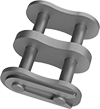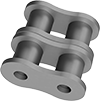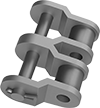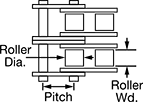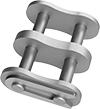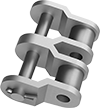About Roller Chain and Sprockets
More
ANSI Roller Chain and Links
Connecting links are also known as master links. They're used to join the ends of a chain length. The side plate is easy to remove for attaching to a chain. Adding links are also known as roller links. They require two connecting links to join chain. Adding-and-connecting links are also known as half links and offset links. A combination of connecting and adding links, they join chain that requires an odd number of links. For trade number 35 and up, the side plate is easy to remove for attaching them to chain.
Corrosion-Resistant ANSI Roller Chain and Links
This 304 stainless steel roller chain is more corrosion resistant than treated steel roller chain.
Connecting links are also known as master links. They're used to join the ends of a chain length. The side plate is easy to remove for attaching to a chain. Adding-and-connecting links are also known as half links and offset links. A combination of connecting and adding links, they can join chain that requires an odd number of links. For trade number 35 and up, the side plate is easy to remove for attaching them to chain.
High-Strength Corrosion-Resistant ANSI Roller Chain and Links
This treated steel chain has over eight times the capacity of stainless steel chain.
Connecting links are also known as master links. They're used to join the ends of a chain length. The side plate is easy to remove for attaching to a chain. Adding-and-connecting links are also known as half links and offset links. A combination of connecting and adding links, they can join chain that requires an odd number of links. The side plate is easy to remove for attaching to chain.


























